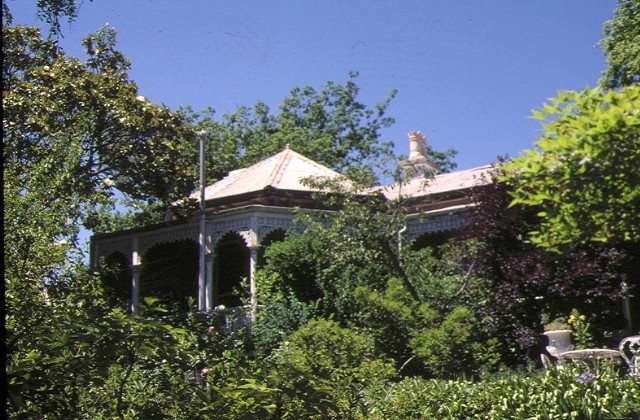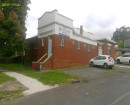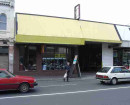TALERDDIG
24 GREENHILL STREET CASTLEMAINE, MOUNT ALEXANDER SHIRE
-
Add to tour
You must log in to do that.
-
Share
-
Shortlist place
You must log in to do that.
- Download report



Statement of Significance
In 1871 Edward Williams purchased a cottage, originally built in the early 1860s, and enlarged it with the addition of two bay-windowed rooms, a cast iron and timber verandah and a drawing room with bedrooms below in 1881 and 1891. He named it Talerddig after his birth place in Wales. The house is a single-storied brick and render building in an elevated setting surrounded by a terraced garden.
Talerddig has historical, architectural, aesthetic and scientific (horticultural) significance to the state of Victoria.
Talerddig is historically significant for its associations with Edward Williams (1842-1909), businessman and politician. Williams had extensive interests in gold-mining and was one of the original promoters and later the chairman of the Ajax Goldmining Company, the chief shareholder of which was George Lansell. He was involved in establishing the Castlemaine Woollen Co Ltd in 1874, eventually becoming its first secretary, principal shareholder and chairman from 1885. The Castlemaine woollen mill, along with the Ballarat mill, was an uncommon industry for the goldfields and upset the pre-eminence of the Geelong mills. The company was particularly noted for its use of mixed cotton and wool fabrics and, as a contemporary source noted, for "the excellence of its flannels and blankets". Williams was a borough councillor for 23 years from 1886 and three times mayor. In 1894 he defeated the premier, Sir James Patterson, for the Legislative Assembly seat for Castlemaine, and remained in the seat until 1904. He was vocal on issues such as mining and liberal causes such as factory legislation and female suffrage. The historical significance of Talerddig is enhanced by its continued association with the family, particularly the granddaughter of Williams, Helen Vellacott, noted author.
Talerddig is architecturally significant as a fine example of a Victorian house, its additions demonstrating the increasing prosperity and importance of its occupants. It retains many original features including fireplaces, cedar blinds in the 1881 and 1891 rooms, ceiling rose, a hand-painted frieze and a distinctive coved ceiling in the 1891 room.
Talerddig is of aesthetic and scientific (horticultural) importance for its design and planting being representative of a nineteenth century gold fields garden, gardenesque layout, ornamentation using urns and slate paving and collection of mature conifers, deciduous trees, shrubs, succulents and bulbs. The garden contains Victoria's only known mature Weeping Silver Linden, Tilia petiolaris 'Pendula'.
-
-
TALERDDIG - History
Contextual History:History of Place:
Talerddig was built some time before 1868. It is recorded in Castlemaine’s earliest surviving rate book of that year as being owned by Allan Ramsay, moulder. In 1871 it was bought by Edward Williams. An article in Table Talk refers to Williams purchasing a cottage and two acres of land “prettily situated on Forest Creek” where he built at a cost of £1200 his “handsome private residence”. It goes on to say that the cottage was many years ago the residence of “Captain” Couchman, a former member of the Public Service Board.
Edward Williams (1842-1909), businessman and politician, was born in Talerddig, Wales. He worked in the woollen industry until he was 17 when he went to Shrewsbury, learnt English, moved to London where he worked in his uncle’s grocery store from 1860 to 1864 and then travelled to Victoria. By 1871 he was running a grocery store in Castlemaine and married Jane Jones in 1872. Williams had extensive interests in gold-mining and was one of the original promoters and later the chairman of the Ajax Goldmining Company, the chief shareholder of which was George Lansell. He was an instigator of the Castlemaine Woollen Co. Ltd. set up in 1874, eventually becoming its first secretary, principal shareholder and chairman from 1885. The company, described in contemporary sources as one of the prominent industries of the colony , was particularly noted for its use of mixed cotton and wool fabrics and for “the excellence of its flannels and blankets.”
Williams was a borough councillor from 1886 to 1909 and three times mayor (1892, 1898 and 1907). In 1894 he beat the premier, Sir James Patterson, for the Legislative Assembly seat for Castlemaine, retiring in 1904. He was involved in issues relating to mining, factory legislation, pensions, fair parliamentary representation, reform of the Legislative Council and female suffrage. He arranged for the prominent female suffragist Vida Goldstein to speak at Castlemaine (in his drawing room) and as a consequence, many more local women joined her society. Williams and his wife had six children, four daughters and two sons. Two of the daughters were educated at Janet Clark Hall (embryonic University of Melbourne) and a musically gifted one was sent to study in London.
Talerddig has remained in the same family and is presently owned by Helen Vellacott, granddaughter of Edward Williams. Helen was brought up in Queensland and later studied economics and history (with Sir Ernest Scott) at the University of Melbourne. She married and lived in Cambridge. Her husband died as a prisoner of war in Singapore, leaving her with two young sons. Helen received a research grant from Cambridge to investigate health services in rural areas. In 1959 Helen returned to Australia to inherit the family home and worked for many years at Castlemaine Hospital as a social worker. After her retirement, Helen published four books. They are:
A Girl at Government House, 1982
Some Recollections of a Happy Life: Marianne North in Australia and New Zealand, 1986
Diary of a Lady’s Maid: Government House in Colonial Australia, 1995
The Australian Country Kitchen, 1995.
Associated People:
TALERDDIG - Permit Exemptions
General Exemptions:General exemptions apply to all places and objects included in the Victorian Heritage Register (VHR). General exemptions have been designed to allow everyday activities, maintenance and changes to your property, which don’t harm its cultural heritage significance, to proceed without the need to obtain approvals under the Heritage Act 2017.Places of worship: In some circumstances, you can alter a place of worship to accommodate religious practices without a permit, but you must notify the Executive Director of Heritage Victoria before you start the works or activities at least 20 business days before the works or activities are to commence.Subdivision/consolidation: Permit exemptions exist for some subdivisions and consolidations. If the subdivision or consolidation is in accordance with a planning permit granted under Part 4 of the Planning and Environment Act 1987 and the application for the planning permit was referred to the Executive Director of Heritage Victoria as a determining referral authority, a permit is not required.Specific exemptions may also apply to your registered place or object. If applicable, these are listed below. Specific exemptions are tailored to the conservation and management needs of an individual registered place or object and set out works and activities that are exempt from the requirements of a permit. Specific exemptions prevail if they conflict with general exemptions. Find out more about heritage permit exemptions here.Specific Exemptions:EXEMPTIONS FROM PERMITS:
(Classes of works or activities which may be undertaken without a permit under
Part 4 of the Heritage Act 1995)
General Conditions:
1. All exempted alterations are to be planned and carried out in a manner
which prevents damage to the fabric of the registered place or object.
2. Should it become apparent during further inspection or the carrying out of
alterations that original or previously hidden or inaccessible details of the
place or object are revealed which relate to the significance of the place or
object, then the exemption covering such alteration shall cease and the
Executive Director shall be notified as soon as possible.
3. If there is a conservation policy and plan approved by the Executive
Director, all works shall be in accordance with it.
4. Nothing in this declaration prevents the Executive Director from amending
or rescinding all or any of the permit exemptions.
5. Nothing in this declaration exempts owners or their agents from the
responsibility to seek relevant planning or building permits from the
responsible authority where applicable.
Exterior
* Minor repairs and maintenance which replace like with like.
* Removal of extraneous items such as air conditioners, pipe work, ducting,
wiring, antennae, aerials etc, and making good.
* Installation or repair of damp-proofing by either injection method or
grouted pocket method.
* Repair or replacement of timber paling fences and gates.
Erection of small, plain (not "period") outbuildings including sheds,
aviaries, kennels, poultry sheds and the like provided that they are not
visible from the front garden and provided that no new outbuilding is larger
than 10 square metres in floor area or 2.4 metres in height.
Interior
* Painting of previously painted walls and ceilings provided that preparation
or painting does not remove evidence of the original paint or other decorative
scheme.
* Removal of paint from originally unpainted or oiled joinery, doors,
architraves, skirtings and decorative strapping.
* Installation, removal or replacement of carpets and/or flexible floor
coverings.
* Installation, removal or replacement of curtain track, rods, blinds and
other window dressings.
* Installation, removal or replacement of hooks, nails and other devices for
the hanging of mirrors, paintings and other wall mounted artworks.
* Refurbishment of existing bathrooms, toilets and or en suites including
removal, installation or replacement of sanitary fixtures and associated
piping, mirrors, wall and floor coverings.
* Installation, removal or replacement of existing kitchen benches and
fixtures including sinks, stoves, ovens, refrigerators, dishwashers etc and
associated plumbing and wiring.
* Installation, removal or replacement of ducted, hydronic or concealed
radiant type heating provided that the installation does not damage existing
skirtings and architraves and provided that the location of the heating unit
is concealed from view.
* Installation, removal or replacement of electrical wiring provided that all
new wiring is fully concealed and any original light switches, pull cords,
push buttons or power outlets are retained in-situ. Note: if wiring original
to the place was carried in timber conduits then the conduits should remain
in-situ.
* Installation, removal or replacement of bulk insulation in the roof space.
* Installation, removal or replacement of smoke detectors.
Landscape
* The process of gardening, hedge clipping, mowing, mulching, bedding
displays, removal of dead plants, disease and weed control, emergency and
safety works and landscaping in accordance with the original concept.
* The replanting of plant species to conserve the landscape character.
* Management of trees in accordance with Australian Standard; Pruning of
amenity trees AS 4373.
* Removal of plants listed as State Prohibited and Regionally Controlled Weeds
in the Catchment and Land Protection Act 1994.
* Repairs, conservation and maintenance to hard landscape elements, urns,
steps, slate paving, gravel paths, rock edging, brick gutters and walls,
driveway, pond, fences and gates.
* Installation, removal or replacement of garden watering and drainage systems
-
-
-
-
-
FLOUR MILL
 Victorian Heritage Register H0395
Victorian Heritage Register H0395 -
BANK OF NEW SOUTH WALES
 Victorian Heritage Register H0131
Victorian Heritage Register H0131 -
FORMER CBC BANK
 Victorian Heritage Register H0712
Victorian Heritage Register H0712
-
"1890"
 Yarra City
Yarra City -
"AMF Officers" Shed
 Moorabool Shire
Moorabool Shire -
"AQUA PROFONDA" SIGN, FITZROY POOL
 Victorian Heritage Register H1687
Victorian Heritage Register H1687
-
'CARINYA' LADSONS STORE
 Victorian Heritage Register H0568
Victorian Heritage Register H0568 -
1 Alexander Street
 Yarra City
Yarra City -
1 Botherambo Street
 Yarra City
Yarra City
-
-















